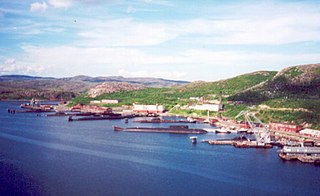 W
WZapadnaya Litsa is a naval base of the Russian Navy, part of the Russian Northern Fleet, located in Murmansk Oblast, Russia.
 W
WThe AVR reactor was a prototype pebble-bed reactor, located immediately adjacent to Jülich Research Centre in West Germany, constructed in 1960, grid connected in 1967 and shut down in 1988. It was a 15MWe, 46 MWt test reactor used to develop and test a variety of fuels and machinery.
 W
WThe Chernobyl Nuclear Power Plant Zone of Alienation is an officially designated exclusion zone around the site of the Chernobyl nuclear reactor disaster. It is also commonly known as the Chernobyl Exclusion Zone, the 30 Kilometre Zone, or simply The Zone.
 W
WThe Church Rock uranium mill spill occurred in the U.S. state of New Mexico on July 16, 1979, when United Nuclear Corporation's tailings disposal pond at its uranium mill in Church Rock breached its dam. The accident remains the largest release of radioactive material in U.S. history, having released more radioactivity than the Three Mile Island accident four months earlier.
 W
WDiorit was an experimental nuclear research reactor at the Swiss Federal Institute for Reactor Research (EIR) in Würenlingen
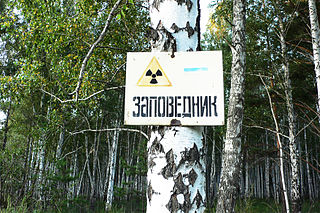 W
WEast Ural Nature Reserve is a Russian 'zapovednik' that is near the site of the 1957 Kyshtym disaster, the world's second highest radioactivity release after Chernobyl. As a state "radiation reserve", the site functions for the protection of a contaminated area, and for long-term scientific study of the effects of radiation on the forest-steppe ecology on the east slope of the southern Ural Mountains. The reserve is situated in the Ozyorsk, Chelyabinsk Oblast. It was formally established in 1968, and covers 16,600 ha (64 sq mi). The reserve, as of 2007, is under the control of Rosatom, a state-run corporation, which conducts regular radiation and radio ecological monitoring.
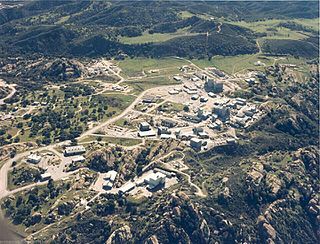 W
WThe Energy Technology Engineering Center (ETEC), was a government-owned, contractor-operated complex of industrial facilities located within the 2,850-acre (11.5 km2) Santa Susana Field Laboratory (SSFL), Ventura County, California. The ETEC specialized in non-nuclear testing of components which were designed to transfer heat from a nuclear reactor using liquid metals instead of water or gas. The center operated from 1966 to 1998. The ETEC site has been closed and is now undergoing building removal and environmental remediation by the U.S. Department of Energy.
 W
WThe Fort d'Aubervilliers is a former fortification of Paris built for 1842 to 1846 in Aubervilliers to control the "route de Flandre", now Route nationale 2, to the northeast of Paris. The Fort d'Aubervilliers is part of the first ring of Paris fortifications outside the old city walls built by Adolphe Thiers in the 1840s to defend the capital against invasion and to control the city's rebellions.
 W
WThe radiation effects from the Fukushima Daiichi nuclear disaster are the observed and predicted effects as a result of the release of radioactive isotopes from the Fukushima Daiichii Nuclear Power Plant following the 2011 Tōhoku 9.0 magnitude earthquake and tsunami. The release of radioactive isotopes from reactor containment vessels was a result of venting in order to reduce gaseous pressure, and the discharge of coolant water into the sea. This resulted in Japanese authorities implementing a 30-km exclusion zone around the power plant and the continued displacement of approximately 156,000 people as of early 2013. The number of evacuees has declined to 49,492 as of March 2018. Large quantities of radioactive particles from the incident, including iodine-131 and caesium-134/137, have since been detected around the world. Substantial levels have been seen in California and in the Pacific Ocean.
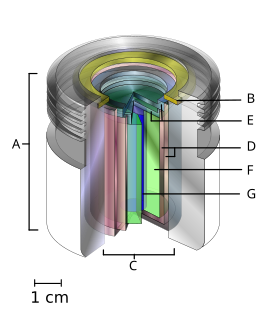 W
WThe Goiânia accident [ɡojˈjɐniɐ] was a radioactive contamination accident that occurred on September 13, 1987, in Goiânia, Goiás, Brazil, after a forgotten radiotherapy source was stolen from an abandoned hospital site in the city. It was subsequently handled by many people, resulting in four deaths. About 112,000 people were examined for radioactive contamination and 249 of them were found to have been contaminated.
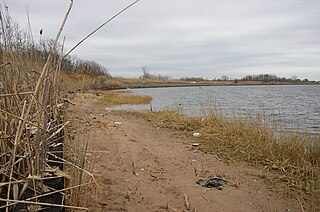 W
WGreat Kills Park is a public park in Great Kills, Staten Island, New York City. Originally named Marine Park, it is a part of the Staten Island unit of Gateway National Recreation Area. Administered by the National Park Service, it covers an area of approximately 580 acres (2.3 km2) of salt marsh, beach and woodlands, stretching along two miles (3 km) of Staten Island's south shore.
 W
WThe Hanford Site is a decommissioned nuclear production complex operated by the United States federal government on the Columbia River in Benton County in the U.S. state of Washington. The site has been known by many names, including Hanford Project, Hanford Works, Hanford Engineer Works and Hanford Nuclear Reservation.
 W
WThe Kramatorsk radiological accident was a radiation accident that happened in Kramatorsk, Ukrainian SSR from 1980 to 1989. In 1989, a small capsule containing highly radioactive caesium-137 was found inside the concrete wall of an apartment building, with a surface gamma radiation exposure dose rate of 1800 R/year.
 W
WThe Kyshtym disaster, sometimes referred to as the Mayak disaster or Ozyorsk disaster in newer sources, was a radioactive contamination accident that occurred on 29 September 1957 at Mayak, a plutonium production site for nuclear weapons and nuclear fuel reprocessing plant located in the closed city of Chelyabinsk-40 in Chelyabinsk Oblast, Russian SFSR, Soviet Union.
 W
WLake Karachay, sometimes spelled Karachai or Karachaj, was a small lake in the southern Ural mountains in central Russia. Starting in 1951, the Soviet Union used Karachay as a dumping site for radioactive waste from Mayak, the nearby nuclear waste storage and reprocessing facility, located near the town of Ozyorsk. Today the lake is completely infilled, acting as "a near-surface permanent and dry nuclear waste storage facility."
 W
WThe Lucens reactor was a 6 MW experimental nuclear power reactor built next to Lucens, Vaud, Switzerland. After its connection to the electrical grid on 29 January 1968, the reactor only operated for a few months before it suffered an accident on 21 January 1969. The cause was corrosion induced loss of heat dispersal leading to the destruction of a pressure tube which caused an adjacent pressure tube to fail, and partial meltdown of the core, resulting in radioactive contamination of the cavern.
 W
WMailuusuu is a mining town in the Jalal-Abad Region of southern Kyrgyzstan. Its area is 120 square kilometres (46 sq mi), and its resident population was 22,853 in 2009. It has been economically depressed since the fall of the Soviet Union. From 1946 to 1968 the Zapadnyi Mining and Chemical Combine in Mailuu-Suu mined and processed more than 10,000 short tons (9,100 t) of uranium ore for the Soviet nuclear program. Uranium mining and processing is no longer economical, leaving much of the local population of about 20,000 without meaningful work. The town was classified as one of the Soviet government's secret cities, officially known only as "Mailbox 200".
 W
WMcGuire AFB/McGuire, the common name of the McGuire unit of Joint Base McGuire-Dix-Lakehurst, is a United States Air Force base in Burlington County, New Jersey, United States, approximately 16.1 miles (25.9 km) south-southeast of Trenton. McGuire is under the jurisdiction of the Air Mobility Command. It was consolidated with two adjoining US Army and Navy facilities to become part of Joint Base McGuire-Dix-Lakehurst on 1 October 2009. The McGuire Air Force Base census-designated place (CDP) is located in portions of both New Hanover Township and North Hanover Township.
 W
WPalomares is an agricultural, fishing, and tourist town along the Mediterranean Sea in the Almería province of Andalusia, Spain. It is about 20 metres above sea level. The village falls within the municipality of Cuevas del Almanzora.
 W
WThe Polesie State Radioecological Reserve is a radioecological nature reserve in the Polesie region of Belarus, which was created to enclose the territory of Belarus most affected by radioactive fallout from the Chernobyl disaster. The reserve adjoins the Chernobyl Exclusion Zone in Ukraine. The environmental monitoring and countermeasure agency, Bellesrad, oversees the food cultivation and forestry in the area.
 W
WLake Karachay, located in the southern Ural Mountains in eastern Russia, was a dumping ground for the Soviet Union's nuclear weapon facilities. It was also affected by a string of accidents and disasters causing the surrounding areas to be highly contaminated with radioactive waste. Although the lake has an area much smaller than that of the Fukushima Daiichi Nuclear Power Plant, and although three settlements, Ozyorsk, Novogornyj and Tatysh some 7 kilometers away are inhabited, and the lake is surrounded by Mayak, the lake is still technically a natural area. It has been described as the "most polluted spot on Earth" by the Worldwatch Institute.
 W
WPripyat, also known as Pryp'yat' or Prypiat was a city in northern Ukraine, near the Ukraine–Belarus border. Named after the nearby river Pripyat, the town was founded on 4 February 1970, as the ninth "atomgrad", a type of closed town in the Soviet Union, to serve the nearby Chernobyl Nuclear Power Plant. It was officially proclaimed a city in 1979 and had grown to a population of 49,360 by the time it was evacuated on the afternoon of 27 April 1986, the day after the Chernobyl disaster.
 W
WThe Rocky Flats Plant, a former U.S. nuclear weapons production facility located about 15 miles northwest of Denver, caused radioactive contamination within and outside its boundaries. The contamination primarily resulted from two major plutonium fires in 1957 and 1969 and from wind-blown plutonium that leaked from barrels of radioactive waste. Much lower concentrations of radioactive isotopes were released throughout the operational life of the plant from 1952 to 1992, from smaller accidents and from normal operational releases of plutonium particles too small to be filtered. Prevailing winds from the plant carried airborne contamination south and east, into populated areas northwest of Denver.
 W
WThe Rocky Flats Plant was a U.S. manufacturing complex that produced nuclear weapons parts in the western United States, near Denver, Colorado. The facility's primary mission was the fabrication of plutonium pits, which were shipped to other facilities to be assembled into nuclear weapons. Operated from 1952 to 1992, the complex was under the control of the U.S. Atomic Energy Commission (AEC), succeeded by the Department of Energy (DOE) in 1977.
 W
WThe Santa Susana Field Laboratory (SSFL), formerly known as Rocketdyne, is a complex of industrial research and development facilities located on a 2,668-acre (1,080 ha) portion of Southern California in the Simi Hills between Simi Valley and Los Angeles. The site is located approximately 18 miles (29 km) northwest of Hollywood and approximately 30 miles (48 km) northwest of Downtown Los Angeles. Sage Ranch Park is adjacent on part of the northern boundary and the community of Bell Canyon is along the entire southern boundary.
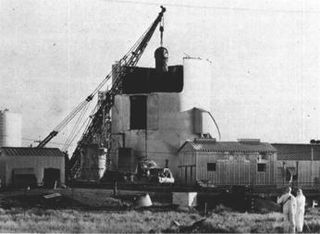 W
WStationary Low-Power Reactor Number One, also known as SL-1 or the Argonne Low Power Reactor (ALPR), was a United States Army experimental nuclear reactor located at the National Reactor Testing Station (NRTS), basis of what is now the Idaho National Laboratory, west of Idaho Falls, Idaho, United States. At 9:01 pm, on the night of January 3, 1961, SL-1 underwent a steam explosion and meltdown, killing its three operators. The direct cause was the improper withdrawal of the central control rod, responsible for absorbing neutrons in the reactor's core. The event is the only reactor accident in U.S. history to have resulted in immediate fatalities. The accident released about 80 curies (3.0 TBq) of iodine-131, which was not considered significant due to its location in the remote high desert of eastern Idaho. About 1,100 curies (41 TBq) of fission products were released into the atmosphere.
 W
WThe West Valley Demonstration Project is a nuclear waste remediation site in West Valley, New York in the U.S. state of New York. The project focuses on the cleanup and containment of radioactive waste left behind after the abandonment of a commercial nuclear fuel reprocessing plant in 1980. The project was created by an Act of Congress in 1980 and is directed to be a cooperative effort between the United States Department of Energy and the New York State Energy Research and Development Authority.